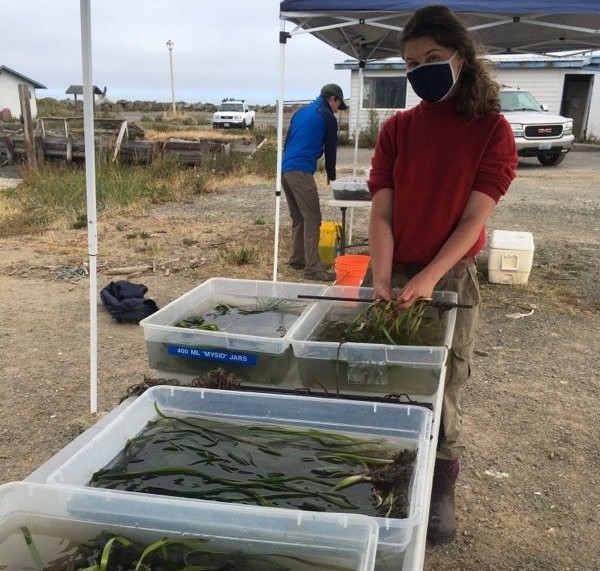An eelgrass planting project at Ediz Hook in Port Angeles Harbor is kicking off, expanding forage and shelter for many fish species in the harbor.
Owing to its numerous benefits to natural resources like fish and aquatic invertebrates, eelgrass planting is one of the key restoration activities identified in the final restoration plan (PDF, 72 pages) for Port Angeles Harbor. The planting project will be the first restoration action implemented as part of the Port Angeles Harbor Restoration Program and is set to kick off in the summer of 2024.
The Port Angeles Harbor Trustee Council—which includes NOAA and other federal, state, and Tribal entities—will provide $92,150 to the Lower Elwha Klallam Tribe(link is external) to work in collaboration with Pacific Northwest National Laboratories (PNNL) to expand eelgrass production, planting, and monitoring at Ediz Hook in Port Angeles Harbor. Starting on May 20, 2024, PNNL staff will remove eelgrass from their outdoor tank nursery, and transport them in coolers to the restoration site, where a shore crew will attach roots to rebar segments and pass them to divers who will bury them in sediment at the correct depths underwater. Monitoring verifies that the methods are working. This funding will support continued eelgrass cultivation by PNNL and a second planting in 2026.

Eelgrass rarely drops seed in our cold waters, so transplanting eelgrass can greatly increase the rate of eelgrass meadow expansion. Baby fish hide and forage in eelgrass meadows at much higher densities than in adjacent shorelines. This work complements shoreline restoration and beach nourishment along the inner beaches of Ediz Hook, also led by the Elwha Tribe. Threatened Hood Canal summer chum and Puget Sound Chinook salmon both leave rivers small in size, and rely on these underwater meadows to grow strong before ocean migration. The young of many other species also use these underwater meadows as a nursery refuge, and the annual sloughing of leaves feeds the coastal food web.
The Lower Elwha Klallam Tribe is a Trustee on the Port Angeles Harbor Trustee Council, and would be acting as a restoration agent to implement on-the-ground restoration actions. The Pacific Northwest National Laboratory (PNNL) has decades of experience in eelgrass cultivation, and has been growing surplus eelgrass plants in large outdoor saltwater tanks since a mitigation project at the Coast Guard base. The Port Angeles Harbor Restoration Program was created to restore pollution-impacted resources with $8.5 million of funds from a 2021 settlement (PDF, 35 pages) with responsible parties.
Case Background
Pollution from industries at Western Port Angeles Harbor has degraded habitats for fish, birds, and wildlife. The Port Angeles Harbor Trustee Council(link is external), made of federal, state, and tribal entities with natural resource trust authorities, has been working together to restore habitat to compensate for those injuries to natural resources, and work towards rebuilding an environment in the harbor where people can fish and harvest from an abundant ecosystem.
In June 2021, the U.S. Department of Justice, on behalf of the Port Angeles Harbor Trustee Council, settled with companies, a local municipality, and a port district for $9.3 million. The Port Angeles Harbor Trustee Council published a Final Damage Assessment and Restoration Plan (DARP) (PDF, 72 pages) for Western Port Angeles Harbor, which determined that the Trustees would develop and manage a restoration program specifically for recovering the natural resources of Port Angeles Harbor. They would use $8.5 million of those funds to implement a restoration program. That program aims to leverage ongoing cleanup activities to maximize restoration of the Harbor.
For more information and to stay in the know, sign up for DARRP’s Coastal Recovery news(link is external).







